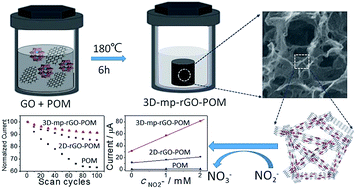A three dimensional, macroporous hybrid of a polyoxometalate and reduced graphene oxide with enhanced catalytic activity for stable and sensitive nonenzymatic detection of nitrite†
Abstract
In this study, a polyoxometalate (POM) and graphene oxide (GO) were hydrothermally treated to form a novel three-dimensional (3D) macroporous hybrid 3D-mp-rGO–POM for nitrite sensing. Scanning electron microscopy, transmission electron microscopy, energy dispersive X-ray spectroscopy, Raman spectroscopy and electrochemical methods were used to characterize the hybrid. The 3D porous rGO not only obviously enhances the conductivity and largely increases the active surface area, but also greatly facilitates the mass transport and efficiently decreases the leaching of the POM from the modified electrode. The synergistic interaction between the POM and 3D porous rGO endows 3D-mp-rGO–POM with a highly stable and efficient electrocatalytic activity towards the oxidation of nitrite. A nonenzymatic sensor for nitrite based on this hybrid shows two linear response ranges of 0.5 μM to 221 μM and 0.221 mM to 15.221 mM, with a detection limit of 0.2 μM (S/N = 3), which displays higher sensitivity, higher stability, a wider linear range and a lower detection limit than sensors based on POMs or 2D-rGO supported POM hybrids. Interference from H2O2 was effectively avoided by monitoring the oxidation current of nitrite instead of its reduction current. The 3D-mp-rGO–POM hybrid with facile preparation, high stability and good catalytic activity may have promising applications in catalysis, sensors, and so on.



 Please wait while we load your content...
Please wait while we load your content...